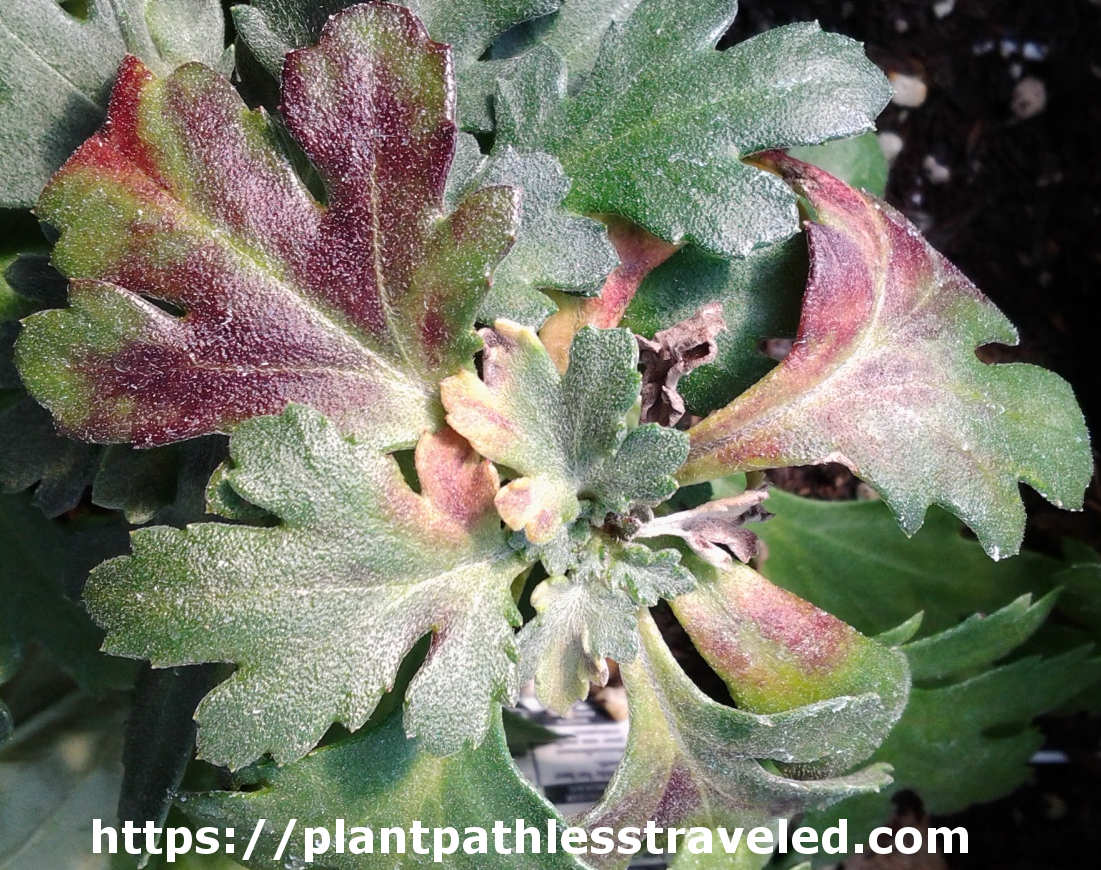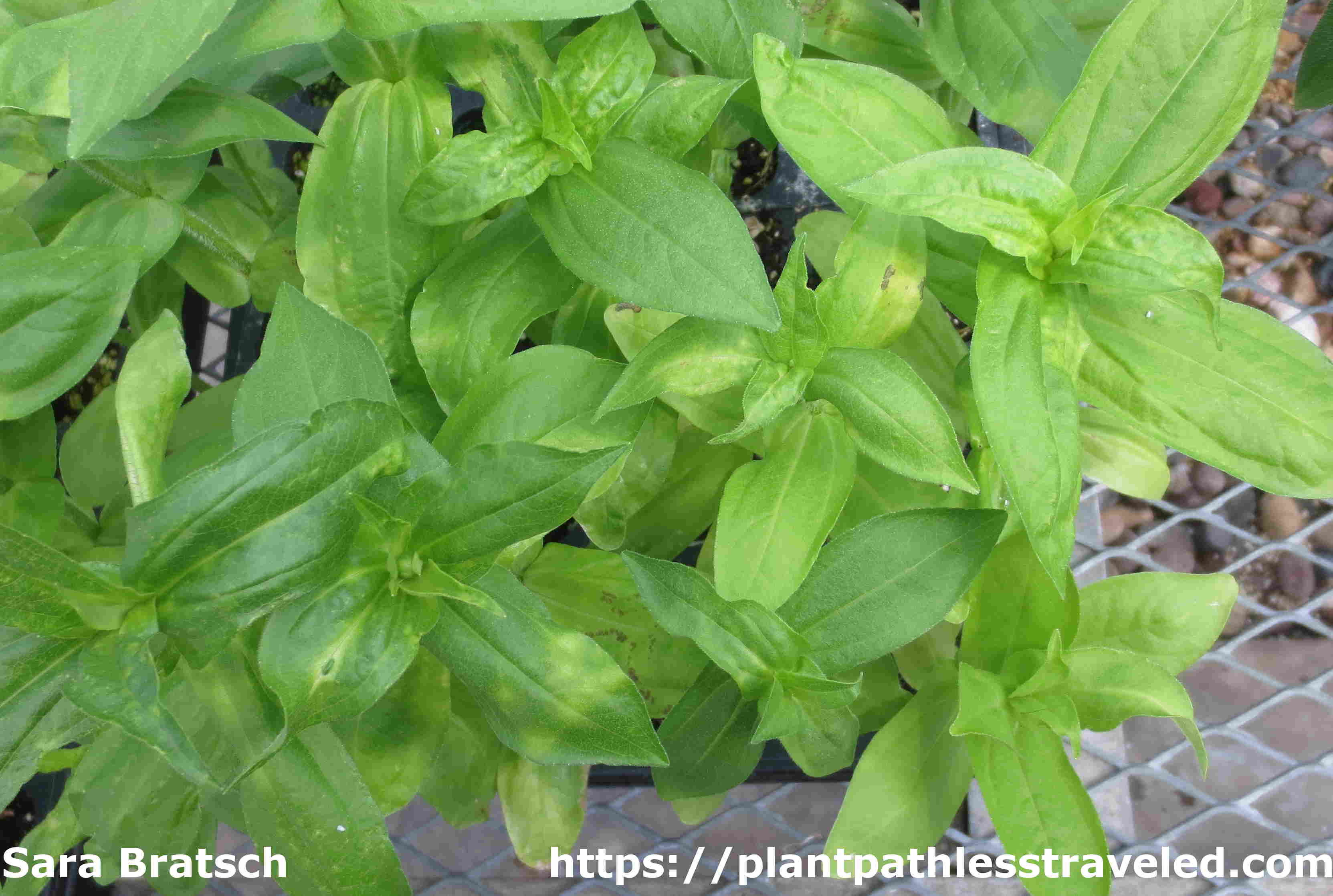TSWV
Tomato spotted wilt virus (abbreviated TSWV) is a serious plant pathogen for both greenhouses and field grown plants. TSWV has an incredibly wide host range of over 1,000 plant species and several thrip species. Symptoms are varied and include: wilting, death of the entire plant, yellow or brown rings on fruit, yellow or brown spots on leaves or distorted leaves. TSWV is only spread by thrip insects. TSWV infection can be tested for by a lateral flow test/immunostrip or a plant disease clinic. Effective control of TSWV requires clean planting material combined with stringent thrip and weed control.
Introduction
TSWV is not a recently described plant pathogen, the first formal publication of the disease was observed on tomatoes in 1915 in Australia (Brittlebank, 1919). TSWV belongs to the virus genus Tospovirus (INSV, impatiens necrotic spot virus, also belongs to this virus group) (Pappu et al., 2009). TSWV utilizes a small insect called thrips to spread from plant to plant. TSWV is a common viral pathogen found in greenhouses and field crops (Pappu, 2012).
TSWV is now present throughout the world along with its thrip vectors (Oliver & Whitfield, 2016). It has been shown to infect over 1,090 plant species from 15 families of monocots, 69 families of dicots, and one family of pteriodophytes (Parrella et al., 2003). These species include such plants as numerous weeds; tomatoes, peppers, potatoes, lettuce, peanuts; and flowering plants including chrysanthemum, petunia, impatiens, and zinnia (Pappu, 2012).
Symptoms
TSWV causes a wide range of symptoms depending upon environmental growing conditions (temperature), age a plant was infected, the genotype of plant, and virus isolate. Young tomatoes may wilt and die, while tomato plants infected later in their life can show brown leaf spots, purple/bronzing of leaves, or chlorotic patterns and ringspots on the fruit. Depending on the strain of TSWV infecting tomatoes they may also show brown streaking along stems and along leaf veins. Symptoms expressed by ornamental plants also vary greatly as the following photos show.
 Chrysanthemum infected with TSWV with symptoms of red splotches on the leaves.
Chrysanthemum infected with TSWV with symptoms of red splotches on the leaves.
 A flat of zinnia infected with TSWV showing symptoms of necrotic rings on lower leaves and distorted, yellowed top leaves.
A flat of zinnia infected with TSWV showing symptoms of necrotic rings on lower leaves and distorted, yellowed top leaves.
 Tomato fruit from a plant infected with TSWV with characteristic symptoms of yellow rings. Fruit can also have necrotic (brown) rings.
Tomato fruit from a plant infected with TSWV with characteristic symptoms of yellow rings. Fruit can also have necrotic (brown) rings.
Transmission
Several species of thrips in the order Thysanoptera can transmit TSWV (Mound 1996). The western flower thrip (Frankliniella occidentalis) is a frequent vector in the USA and Canada (Rosello et al 1996; Allen & Broadbent, 1986).
TSWV is transmitted by thrips in what is called a persistent propagative manner. After a thrip has fed on an infected plant, the virus will pass through its digestive system into the circulatory system. The virus particles are then circulated into the salivary glands where TSWV replicates and can be transmitted to other plants the thrip feeds on. Since the virus is replicating in the insect vector, an infected insect can transmit the virus until it dies. Depending on thrip species it can take as little as 15 minutes of feeding on virus infected plants for them to acquire the virus (Sakuma, 1962). Thrips can only acquire the virus when they are larvae, after pupating into their adult form they cannot acquire and transmit TSWV (Wijkamp, 1993). Both adults and young thrips can transmit TSWV so the presence of both should be monitored.
TSWV is not easily mechanically transmissible and is also not transmitted by seed (Pappu, 2012).
Testing
Symptomatic plants can be tested for the presence TSWV in the field with an immunostrip/lateral flow test or can be sent into a plant diagnostic clinic.
Control
Control methods to limit losses by TSWV infections rely upon good management practices including plant resistance, vector control, and quarantining new arrivals. Resistant varieties of tomatoes, peppers, and peanut have been developed and can be used to limit TSWV losses. Plant resistance to TSWV varies for different strains of TSWV so varieties with multiple resistance genes should be used (Mandal et al., 2006). Greenhouses receiving live transplants should quarantine new arrivals to check for thrips (which may be carrying TSWV) or for the development of symptoms. Thrip levels should be monitored with sticky traps or physically examining plants. When needed insecticides should be used carefully to ensure the thrip population is reduced after application.
Production areas outside of enclosed greenhouses should also quarantine new transplants to ensure no symptoms develop. Silver reflective mulch has been shown to keep thrip populations low, decreasing the incidence of TSWV infected tomato plants (Riley & Pappu, 2004). Weeds and native plants should be managed as 113 plant species native to Ontario (in 35 plant families) can be infected by TSWV and act as a source of virus to infect crops (Stobbs et al., 1992).
Plants cannot be cured once infected by a virus and should be destroyed. It is useful to identify the virus causing symptoms so that an effective management plan can be created and followed to limit production losses the following year.
All photos taken by Sara Bratsch. For non commercial use only.
Please contact regarding all other uses including but not limited to: data for computational algorithms, books, pamphlets, articles, apps, websites, etc.
Cite this article:
Bratsch, Sara. "TSWV". Web article. (date accessed). http://plantpathlesstraveled.com/TSWV/
Citations
Allen, W. R., & Broadbent, A. B. (1986). Transmission of tomato spotted wilt virus in Ontario greenhouses by Frankliniella occidentalis. Canadian Journal of Plant Pathology, 8(1), 33-38.
Mandal, B., Pappu, H. R., Csinos, A. S., & Culbreath, A. K. (2006). Response of peanut, pepper, tobacco, and tomato cultivars to two biologically distinct isolates of Tomato spotted wilt virus. Plant Disease, 90(9), 1150-1155.
Oliver, J. E., & Whitfield, A. E. (2016). The Genus Tospovirus: Emerging Bunyaviruses that Threaten Food Security. Annual Review of Virology, 3, 101-124.
Pappu, H. R., Jones, R. A. C., & Jain, R. K. (2009). Global status of tospovirus epidemics in diverse cropping systems: successes achieved and challenges ahead. Virus research, 141(2), 219-236.
Pappu, H. R. (2012). "Tomato spotted wilt virus." http://plantpath.wsu.edu/wp-content/uploads/2012/10/Pappu-final-version.pdf
Parrella, G., Gognalons, P., Gebre-Selassie, K., Vovlas, C., & Marchoux, G. (2003). An update of the host range of Tomato spotted wilt virus. Journal of Plant Pathology, 227-264.
Riley, D. G., & Pappu, H. R. (2004). Tactics for management of thrips (Thysanoptera: Thripidae) and tomato spotted wilt virus in tomato. Journal of economic entomology, 97(5), 1648-1658.
Stobbs, L. W., Broadbent, A. B., Allen, W. R., & Stirling, A. L. (1992). Transmission of tomato spotted wilt virus by the western flower thrips to weeds and native plants found in southern Ontario. Plant Disease, 76(1), 23-29.
Wijkamp, I., van Lent, J., Kormelink, R., Goldbach, R., & Peters, D. (1993). Multiplication of tomato spotted wilt virus in its insect vector, Frankliniella occidentalis. Journal of General Virology, 74(3), 341-349.